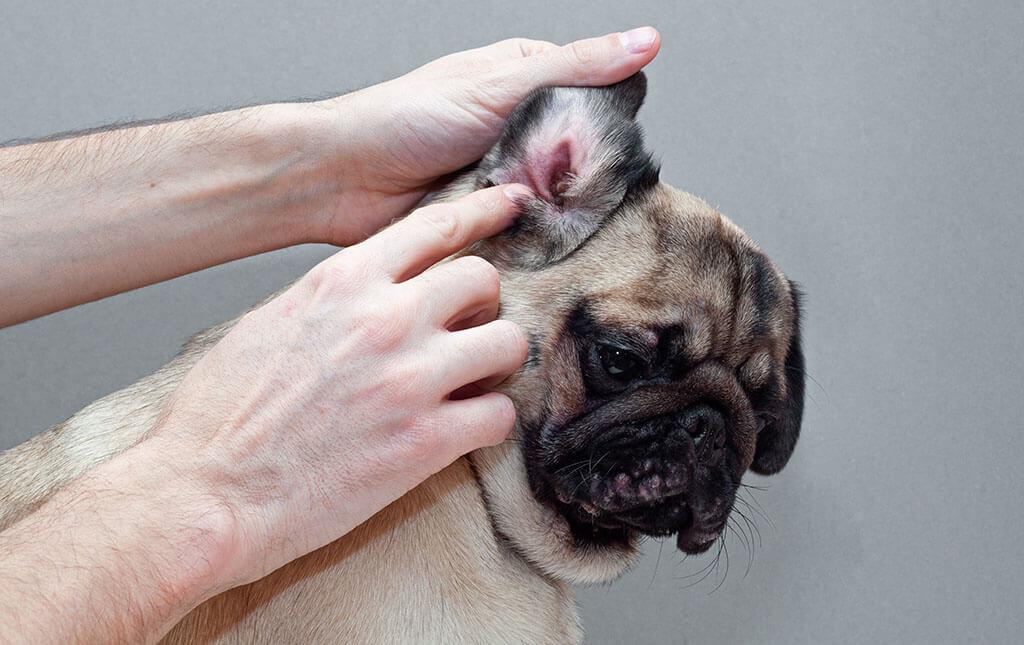Discover how to identify, treat, and prevent ear mites in dogs with our comprehensive guide. Uncover symptoms like itchiness and dark discharge, learn about direct transmission among pets, and explore effective treatments, including prescription options for instant relief.
- Home/
- Dog/
- Health & Wellness/
- Does My Dog Have Ear Mites?
Does My Dog Have Ear Mites?

Have you ever wondered if your dog has ear mites? Ear mites in dogs are uncommon but can cause a lot of discomfort when they show up. If your dog has ear mites, they might get an ear infection or even scratch their ears raw, so it’s important to know what to look for and how to get rid of them if they show up.
Key facts:
- Ear mites are uncommon in dogs.
- Ear mites are passed directly from one animal to another.
- Ear mites cause itchiness as well as dark brown to black discharge from the ears.
- Ear mites can only be diagnosed with magnification.
- There are many options for treating ear mites, but the only ones that work with a single dose are prescription-strength.
- Most of the prescription medications that treat ear mites also prevent them.
What Are Ear Mites?
Ear mites, whose scientific name is Otodectes cynotis, are mites that typically live in the ears of dogs and cats. They live in the external ear canal, which is the part we can see from the outside, and eat the ear wax your dog naturally produces.
They are just barely visible, so it’s not likely you’re going to see them even if your dog does have ear mites. Your vet is more likely to see them when they use a magnifying otoscope to look in your dog’s ears, but even then, they’re often hiding where they can’t easily be seen. The best way to diagnose ear mites is to look at a sample from the inside of the ears under a microscope, which your veterinarian can do in the office.
An ear mite infestation generally causes two things in dogs: discharge from the ears and severe itchiness of the ears. Both problems can lead to other issues, such as ear infections or wounds from scratching, so don’t ignore them if they come up!

How Does A Dog Get Ear Mites?
Really, how do dogs get ear mites? Ear mites are passed directly from one pet to another. They are usually picked up during play, grooming, or other activities where your dog’s skin can touch another dog’s skin. This means that your dog could easily pick up ear mites at the dog park or if a friend brings their dog over for a play date. It also means that if you think your dog might have ear mites, you should keep them away from places where they might come in contact with other dogs. No patio dining for your pup until things get better!
Because ear mites are more common in cats than dogs, dogs that spend time with cats are more likely to end up with ear mites. Most people aren’t letting their dogs hang out with unknown cats (most cats won’t put up with that, either!), but if you have a cat that goes outside, that could put your dog at risk.
How Can I Tell If My Dog Has Ear Mites?
Unfortunately, a dog’s ear mite symptoms look very similar to the symptoms of an ear infection. Both can cause itchiness and discharge from the ears, though the discharge can look different depending on what’s going on.
Ear mites usually cause a dark brown to black, thick, chunky discharge that looks like used coffee grounds. This discharge helps to protect them from the immune system and medication, and is why they can be almost impossible to see without a microscope.
The discharge from certain ear infections can also be dark brown to black and thick but usually doesn’t crumble like discharge from ear mites does. Your veterinarian might have a good guess about what’s going on based on the appearance of the discharge, but seeing the mites is the only way to be sure.
Scabies is another disease that can cause severe itchiness around your dog’s ears. But scabies on a dog’s ears usually doesn’t cause discharge from inside the ear. Instead, the ear flap (your vet might call it the pinna) will often lose fur, and the skin can turn pink or even bright red. Strangely, the mites that cause scabies are related to ear mites and look similar under a microscope!
What Can I Do If My Dog Has Ear Mites?
There are many options for treating ear mites, and it’s always a good idea to talk to your veterinarian about the best choice for your pup. But let’s go over some of the options here!
What Kills Ear Mites Instantly?
There are several medications that will get rid of ear mites with a single dose. The biggest problem is that they are all prescription, so you can only get them from your veterinarian.
The options include topical products, injections, and oral medications. Topical products are either put directly in the ear or applied to the skin on another part of the body, like the back of the neck. How it is put on depends on the product, so make sure you know how to use it before treating your dog.
When using medications that are put directly into the ears, you need to do a thorough cleaning first. If there’s any discharge left in the ears, the mites can hide inside it, and the medication might not work. For this reason, many veterinary clinics will clean the ears and apply the medication for you right there in the office.
Topical products that are applied to the skin and oral products usually control parasites like fleas and ticks as well. These can be sent home with you, or your vet might go ahead and take care of it for you (especially if you ask). Injections are not commonly used anymore, but these also would be given right there in the veterinarian’s office.
None of these treatments kills instantly, but you should see relief within minutes to hours, so it’s close enough! And as long as you’re at the vet’s office to pick one of these up, they can also prescribe something for your pup’s comfort if needed.
Ear Mite Treatments For Dogs
Many of the new parasite control options will treat or prevent ear mites. So you can easily protect your canine companion against not only ear mites but also fleas, ticks, heartworms, and even intestinal parasites all at once. Products like Revolution Plus and Advantage Multi can provide parasite protection that will help keep your pup as healthy as possible!
There are plenty of other options if you’re happy with your current parasite prevention plans and just need to treat your pup’s ear mites. Most of these options will be put directly into the ears and may need to be applied daily for a while. This option works just as well as the others but is a little trickier if your furry friend doesn’t want you touching their ears.
You can find ear mite remedies at both your vet’s office and the pet store. As with human medications, you’ll be able to get stronger products from your veterinarian that work faster than over-the-counter. If you choose an over-the-counter product, make sure to follow the instructions exactly. Many of these must be used for several weeks or even an entire month to kill all the mites. If they aren’t used for long enough, the infestation will come right back again.
Home Remedies for Ear Mites
If you find yourself in a situation where you can’t even get to the pet store for an over-the-counter option to treat ear mites, you can still do something at home. Home remedies are unlikely to clear the infestation completely, but they can provide a bit of comfort until you can get to the store or the vet.
To treat ear mites at home, clean your dog’s ears with olive or mineral oil. These can be purchased at your local drugstore or grocery store. Oil works by helping to break down the discharge and drown the mites. This means you will need to massage the ears to break up and remove the discharge, and it is unlikely to get all the mites. But removing some of the mites will help keep your pup more comfortable until you can take the next steps. If you want to try treating this way, you will need to do this every day for at least a month and clean with an ear cleaner a couple of times a week to remove buildup before re-applying.
Do not use any rubbing alcohol or hydrogen peroxide to try to treat ear mites in your dog. Not only will these not work, but they can damage the inside of the ears and increase the risk of infection.

Preventing Ear Mites
Many of the same products mentioned as one-time treatments for ear mites will also prevent the infestation from appearing in the first place. All products that prevent ear mites are prescription strength, so you’ll need to talk to your veterinarian about which is best for your dog.
One of the most critical steps in preventing ear mites and other ear trouble is to check and clean your dog’s ears regularly. Doing this has several advantages.
First, it will help you become familiar with what is normal and what isn’t for your dog. Dogs naturally have brown ear wax, but you’ll learn how much is normal for your dog as well as the normal color of the skin in their ears.
Second, it means you will notice sooner if there is a problem. Disease is always easier to treat earlier, so this is very helpful when dealing with ear mites.
Last, if you’re cleaning your dog’s ears regularly (don’t forget the treats for being good!), they will be used to having their ears handled. When a dog has itchy or painful ears, they don’t want anyone else touching them. If they are used to trusting you to be gentle when you clean, it will be much easier to treat any ear problems that come up.
In addition to keeping your dog on parasite prevention and checking on their ears regularly, keep your cat on parasite prevention and keep your dog away from unknown cats. Since ear mites are much more common in cats than dogs, this is an important way to reduce your pup’s risk.
Final Thoughts on Ear Mites in Dogs
Even though ear mites are uncommon in dogs, they do happen. Like most diseases, ear mites are easiest to treat when caught early. Routinely checking and cleaning your dog’s ears is key for early detection. Remember that ear mite symptoms in dogs can look a lot like an ear infection. If you notice something wrong, the best way to find out if it is ear mites or another type of ear infection is to get your pup checked by your veterinarian as soon as possible. They can diagnose the problem, give you the appropriate treatments, and even discuss preventative medication to make sure you never have to deal with this again!
FAQs
Can ear mites in dogs lead to more serious conditions?
Yes. The discharge can build up and increase the risk of ear infections, and the itchiness can cause your dog to scratch their ears raw.
Are certain breeds more susceptible to ear mites?
No. There is no increased risk of ear mites in any age, breed, or sex of dogs. The risk factors are contact with cats and other dogs that are infected.
How can I tell the difference between ear mites and other ear infections?
Telling the difference between ear mites and infections can be very difficult since both conditions are most accurately diagnosed using a microscope and a sample of the discharge. Ear mites usually produce a thick, dark brown to black, crumbly discharge that resembles coffee grounds. If you see something that looks like that, you can be suspicious, but you need to have your pup seen by your veterinarian to be sure.
Can humans get ear mites from dogs?
No. Dogs, cats, and even ferrets can get ear mites, but humans do not.
How long does it take to treat ear mites in dogs?
Ear mites can be treated with as little as a single dose of medication from your veterinarian. If you plan to use an over-the-counter treatment or home remedy, be prepared to treat them daily for a month or more.
Are over-the-counter medications effective for ear mites?
Yes, though more slowly than prescription medications.
Can ear mites be prevented?
Yes! Many modern medications that prevent fleas and ticks also prevent ear mites.
Can I do anything to avoid an ear mite infestation?
Yes. Keeping your dog on prescription-strength parasite prevention that covers ear mites is nearly 100% effective. You should also check and clean your dog’s ears regularly so you catch any problems early.
Sources:
Veterinary Partner: Ear Mites in Dogs, Accessed 2/3/24, https://veterinarypartner.vin.com/default.aspx?pid=19239&id=4951535
PetMD: Ear Mites in Dogs, Accessed 2/3/24, https://www.petmd.com/dog/conditions/infectious-parasitic/ear-mites-dogs#treatment
Forbes Advisor: Ear Mites in Dogs: Symptoms, Treatments, and Remedies, Accessed 2/3/24, https://www.forbes.com/advisor/pet-insurance/pet-care/ear-mites-in-dogs/
 J
J




